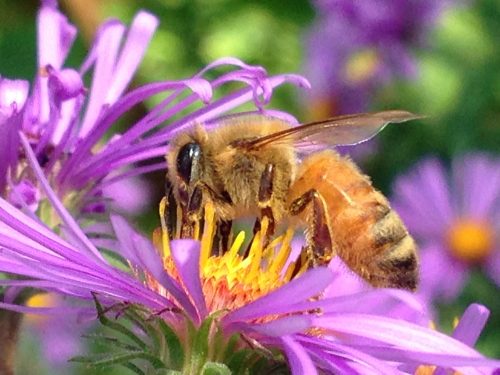
Apis, photographed by Gretel Kiefer
Family: Apidae
Genus: Apis
Common Name: Honey Bees
Length: 10-15 mm (0.4-0.6 in)
Link to DiscoverLife: Apis
Identification: Apis individuals are moderately hairy and elongated, with hairy eyes and a variance in color, from black to amber brown. They have stripes on their abdomens, and the females have corbiculae on their rear legs for carrying pollen. Morphological differences exist between the queen, her female worker, and the male drones. The queen is the largest of the three. The males have large eyes and congregate in specific areas to mate with the virgin princesses.
Foraging Habits: Generalists. Apis are common in our study area but are not visitors to Echinacea.
Nesting Habits: Apis are social bees living in perennial colonies, hoarding honey to support the colony when foraging is limited. They occupy large cavities where they make vertical combs of hexagonal cells using wax secreted from special glands. The hive is also filled in with propolis, which is a mixture of plant resins. The queen’s only role is to lay eggs, and the male drone’s only role is to fertilize the queen. The worker bees (all female) perform all of the tasks necessary to supporting the hive according to age. Young workers tend to larvae and clean the hive, then protect the entrance, then forage for food outside the hive. New hives are formed by division, and a new queen is raised while the old one leaves with a swarm of workers to establish a new hive.
Specimens in Collection: 3 specimens
Species Observed: Apis mellifera
Supplemental Images: Apis mellifera
(Mader et al. Attracting Native Pollinators: Protecting North America’s Bees and Butterflies. 2011. The Xerces Society.)
